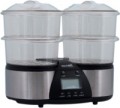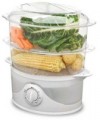Total volume
The volume of all steam baskets is indicated. The larger it is, the more food/dishes can be cooked at the same time. Meanwhile, do not forget that this parameter also affects the dimensions and price of the device. Therefore, it is worth specifically looking for a capacious steamer if you cannot do without it.
For a family of 3 – 4 people, the volume of about 6 – 7 L is considered optimal. At the same time, we note that most steamers are equipped with several baskets, and it is not necessary to use them all at once when cooking. Therefore, for the same family of 3 – 4 people, a
larger volume model may be suitable, for 10 – 11 L: for everyday cooking, you can use part of the baskets, and the reserve by volume can come in handy if you have to cook in large quantities (for example, for the holiday).
Capacity
The number of individual baskets in a steamer or seats for eggs in an egg boiler (see “Type”).
In the first case
, 2–3 baskets are most often provided, depending on the volume of the device. A larger quantity is unjustified from the point of view of cooking efficiency - in “multi-story” designs, the products in the upper baskets potentially will not be able to cook properly, since there will not be enough warm steam reaching them. There are
4-basket steamers, however they are rare and usually have a 2x2 layout - 2 stacks of 2 tiers. The other extreme -
1 basket - is typical for the most compact devices (volume up to 3 - 4 liters).
In the case of egg cookers, everything is simple - the choice is based on how many eggs are supposed to be regularly cooked in the device at a time. The most popular options have a capacity of
7 - 8 eggs, less often -
9 - 10 eggs. This is quite enough, for example, to prepare breakfast for an average family. The minimum number of nests for eggs is 3, devices with the number of slots
≤ 6 pcs. designed for one, maximum two people. And in the most capacious egg boilers this figure can
exceed a dozen eggs.
Rice bowl
The presence in the delivery set of a special bowl designed for cooking porridges from cereals that need to be filled with water, in particular rice and buckwheat. The bottom
of the rice bowl has no openings, which allows you to pour the right amount of water into it. Heating occurs due to the steam produced by the steamer.
Power
The maximum power consumed by the steamer during the cooking process; in many modes, the actual power consumption may be lower, but you should focus on the maximum power. The
more powerful the device, the more intense heating it provides, the faster the water in it will heat up to the desired temperature and the more powerful the release of steam, which is useful for large volumes of cooking. On the other hand, high power usually affects the cost, and power consumption increases accordingly.
Control
—
Rotary switches. This type usually refers to electromechanical control — rotary knobs directly affect the corresponding elements of the steamer, without additional control schemes. This option is very simple and inexpensive, but the control options are quite modest and usually limited to the most basic functions. Therefore, it is mainly used in entry-level models.
—
Pushbutton switches. Control of the electronic type, carried out through specialized schemes. The cost of this option is higher than rotary switches, however, the possibilities are incomparably wider. In particular, the steamer can be equipped with automatic cooking programs and an extended set of timers (at the same time, the accuracy of setting the time will be very high), as well as various additional settings.
—
Sensory. Control, in many respects similar to the push-button (see above) — in particular, the set of features is also very extensive. However, it is based on sensors. The key difference is that the sensor does not need to be pressed unlike a button — it is activated by touch, which is very convenient. In addition, touch panels have a futuristic appearance and a smooth surface that makes cleaning much easier. On the other hand, such equipment significantly affects the price of a steamer.
Functions
—
Fast heating. Allows you to start cooking almost immediately, without wasting time on waiting and preparing.
—
Thermostat. Many dishes require cooking at a stable temperature, in strict accordance with the instructions of the recipe. The presence of a thermostat allows you to maintain a constant temperature in the steam baskets or change it at a given time in accordance with the cooking program in some steamers.
—
Autocooking. Allows you to cook according to the programs built into the steamer. At the same time, the duration of operation, temperature conditions (including temperature changes at different stages) and other parameters are controlled by the steamer, and you do not have to monitor the parameters and change them manually.
—
Auto-off timer. A special device that turns off the steamer after a predetermined time. The presence of a timer will allow you not to worry about the quality of cooking and eliminates the need to monitor the time: the steamer will turn itself off at the right time.
—
Delay start timer. A timer that allows you to turn on the steamer not immediately, but after a certain specified time. This provides additional convenience: for example, you can load the device in the evening and set the start time for the morning — in this way, the porri
...dge will be ready for breakfast, and you will not have to get up earlier to “load” the steamer.
— Water level indicator. It allows you to constantly monitor the water level in the steamer and as a result, ensure that the necessary cooking conditions are correctly observed. Many steamers provide for adding water if it is not enough.
— Possibility of adding water. The lack of water during cooking can lead to disastrous consequences - in particular, the dish will be cooked in a completely different way than the owner of the steamer expected. The possibility of adding water allows you to correct the mistake in a timely manner.Display
The presence in the design of the steamer of its own
display. Usually, this is the simplest digital indicator, sometimes with additional icons. However, even the simplest options greatly simplify and facilitate control, because they can display a wide variety of information: data on the current programme, time (total operating time, time until a timer starts), temperature, error messages, etc.

